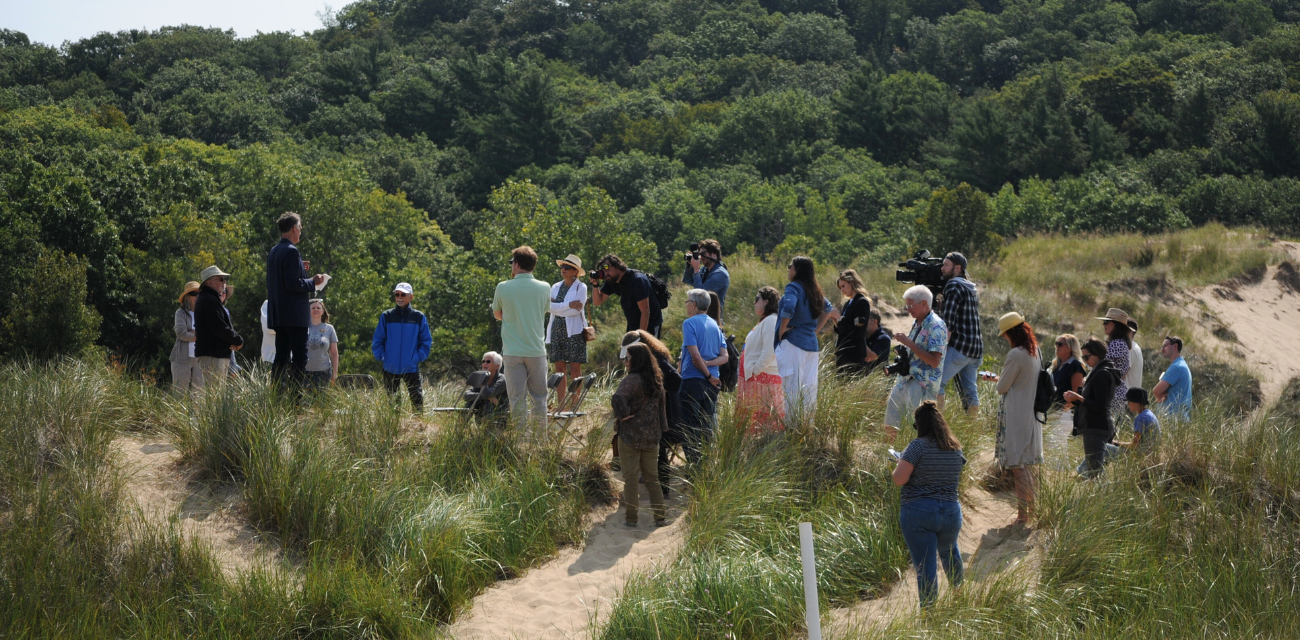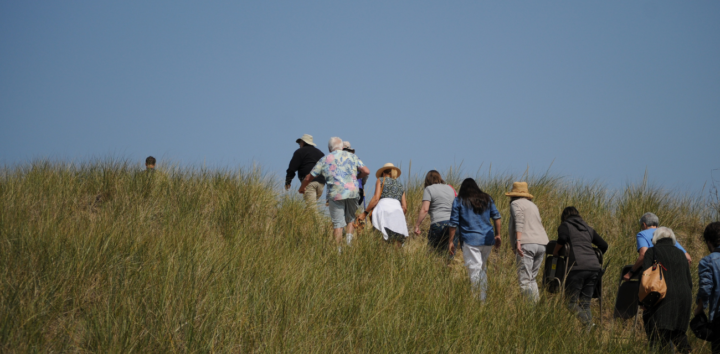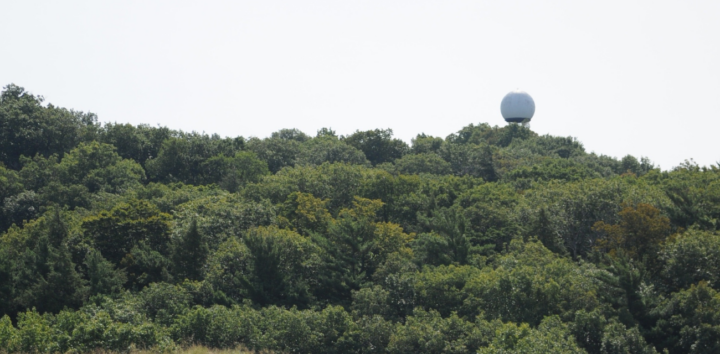What might Michigan’s dunes future look like? Hi, Saugatuck

Authored by
With landmark dunes legislation on the horizon, Saugatuck Dunes Coastal Alliance puts it all into perspective
The walk, in the photo, looks resolute, like a pilgrimage. People walk single-file up a dune, away from the camera below, tan sands around them and a cloudless sky above.
Really, the occasion was much happier. About 40 people had just wrapped up a press conference in which two Michigan state representatives—Rachel Hood (D-Grand Rapids) and Joey Andrews (D-St. Joseph) just finished announcing landmark legislation to protect Michigan’s most fragile and unique freshwater dunes. Now, a contingent of the audience was heading into a dune.
Leading the tour was David Swan, president of the Saugatuck Dunes Coastal Alliance, a group of residents of the Saugatuck area that had worked diligently for decades to protect their namesake from dangerous development and to create a place where both communities and wildlife thrive. They do so for good reason: Michigan is home to the largest freshwater assemblage of dunes in the world. They’re globally rare and imperiled. Saugatuck sits on the most fragile of them all: dubbed a “critical dune.”
Michigan coastal dunes are beloved, Saugatuck is beloved, and that love stems from something unnamable shared between the two. But those coastal dunes are also at risk, and Saugatuck is perhaps a stalwart example of a community that has embraced its natural heritage rather than the norm.
Neither of these realities are the faults of developers or government leaders. People want to live and play near dunes, and leaders want to both encourage that living and playing to properly preserve what drives people to the west coast.
The fault lies in vague laws that leave developers encouraged to build dangerously and governments large and small ill equipped to respond. Rep. Andrews’ and Rep. Hood’s legislation is meant to better clarify the process and to better encourage good, smart development on and around our critical dunes.
It was Swan’s job to take the audience atop the crest of a dune and give them a 360-degree tour of the area, to see what was at stake and what a future under the bills might look like.

Calling a dune a dune
Saugatuck Dunes Natural Area was just north of David’s party, between the water of Lake Michigan and the bend of the Kalamazoo River. Its 173 acres are a “unique microclimate,” said Swan. Landscapes range from jack pine to forest to wetland to, yes, sand. Within are some of the most diverse wildlife in the state, from the vulnerable eastern box turtle to the endangered pitcher’s thistle.
Yet, every acre is part of a larger critical dune ecosystem. It’s not just sand.
“I think a lot of us as Michiganders just stop our thinking there,” Swan said. “Critical dune areas are much more than that.”
And they move. A healthy dune is one that, over years and years, travels down the coastline, pushed by wind coming off the lake on one end but kept from blowing away by greenery on the other. Interspersed wetlands and other watery features supply the groundwater that keep the landscapes lush and the sandy crests, well, crested. And all along, wildlife travels within and with the dunes. The eastern box turtles travel by foot and the pitcher’s thistle travel by proliferation.
The legislation of Rep. Hood and Rep. Andrews acknowledge this, the diverse landscape of dunes and their dynamism in ways past legislation hasn’t. That in turn, allows their legislation to better protect dunes and their inhabitants contiguously, from sandiest shoreline to thickest forest to murkiest wetland.

Keeping things interconnected
Place an ill-advised series of drives, roads and buildings on a dunes ecosystem and it get locked into place. It can impede the necessary migration of flora and fauna. It can cause grasses to cover up the naked dunes we love. Take enough greenery away, and the dunes can blow away—or atop civilization.
Even development a ways away from a critical dune can critically impair them. Swan pointed out the 300-acre Patricia Birkholz Natural Area within the 1,000-acre Saugatuck Dunes State Park. The entire ecosystem was lowered by a couple inches when mining began a mile away, irrevocably changing it. The reason: Groundwater between the mined area and the natural area was connected.
As the cliché goes, location, location and location are the three factors that make for good property values. So how can homes, businesses, mines, you name it, make it within critical dunes that need their space?
“One can thoroughly enjoy their private property rights in the critical dunes without having to remake metro suburban anywhere in the dunes,” Swan said.
He pointed out examples around Saugatuck by turning his audience’s eyes inland. To their right was the 115-year-old Ox-Bow School of Art, entirely built within the critical dunes of Saugatuck. For aesthetic and environmental purposes, its artists in residence reside in 100-year-old cottages and create without the need for massive facilities or roads leading to them.
Nearby is a home on Oxbow Lagoon. No roads lead to it, either, and its owners opt for canoes over motorized boats to go out. A scruffy, two-track road does lead up to historic cabins, through. Neither has a foundation but conscious of the freeflowingness of the dunes underneath, its owners are using cylindrical pilings instead to allow the dune to move around the structures—and keep the cabins from toppling by that movement.
Beyond both art school and private home is Tallmadge Woods, 102 acres of old-growth forest and marsh purposely preserved to protect these places and the ecosystem they’re atop from encroaching development.
It all makes clear the need for protected areas to be interconnected, Swan said. It gives dunes and their wildlife space to move, and it better insulates a loss of nature in one part of that protected area from affecting the rest.
If developers want to construct atop a globally rare, universally beloved ecosystem, these are the sorts of architectural innovations they might build and lifestyles they might encourage under Reps. Andrews’ and Hood’s legislation. Less roads, smaller homes, literally flexible foundations.

Growing with, not over
The sorts of development Swan pointed out on his tour may sound tedious, granola-y, even frivolous to some. And these examples are perhaps more aesthetically extreme. But, again, Saugatuck provides a glimpse at what this reality might truly look like. It gets at what Swan and others constantly reiterated as the third mechanic of Michigan’s forthcoming dunes legislation: economic prosperity.
Swan had his audience turn around to look at where they had come from.
Before them (and below them) was the 41-acre Oval Beach, where, even on a late Wednesday morning, scores of people were already lounging, playing and running into the cold waves. Condé Nast once called it the second-best beach in the world.
Wrapping its arms around the beach was Mount Baldhead Park, 100 acres of mostly interdunal forest made famous by three landmarks: a replicated 19th-century town; a historic satellite tower-like radar ball; and Mount Baldhead itself, a 302-stair-tall sand dune.
Then there was Saugatuck itself. The city,, along with neighboring Douglas and Saugatuck Township were staples of beach life. That meant plenty of cottage-style homes and tourist attractions, yes, but also a clear appreciation for wild things. Stitched among homes and yards were woods and ponds. Parks and beaches and natural areas popped up farther in the distance.
In these instances, humanity gets better when it grows with, not upon our most precious places. These are the sorts of ‘sideline’ development Reps. Andrews’ and Hood’s bills were meant to encourage. That, in turn, creates great hometowns and destinations to relish in; cultural landmarks to visit; trails and beaches to recreate on; and untrammeled nature to admire.
“This protected landscape, this protected dune landscape, this is our economy,” Swan said, noting the $225 million it brings in each year. “This is why people visit Saugatuck. This is why Saugatuck is on so many lists for the best tourist place to visit in the State of Michigan. And that is why Reps. Hood and Andrews have worked so hard over the course of… the last six years trying to bring these bills forward. This is, as I just keep saying, an economic plan for our future.”
Discover
Power environmental change today.
Your gift to the Michigan Environmental Council is a powerful investment in the air we breathe, our water and the places we love.
Sign up for environmental news & stories.
"*" indicates required fields




